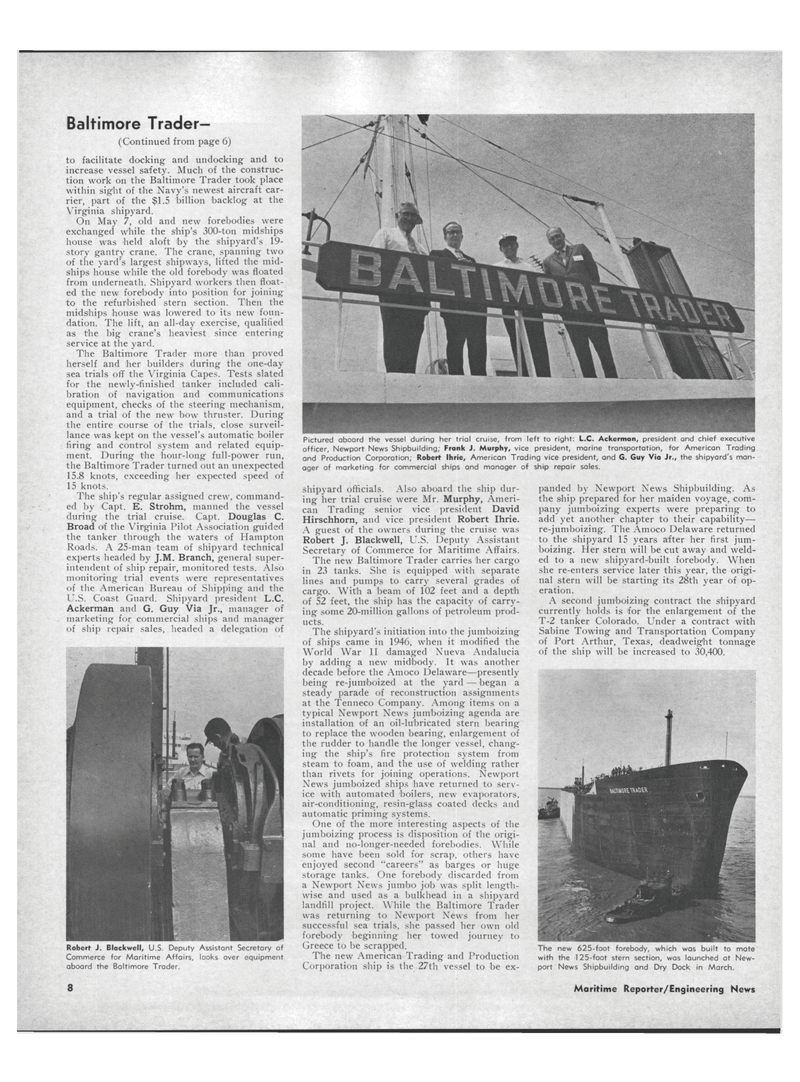
Page 6: of Maritime Reporter Magazine (August 1971)
Read this page in Pdf, Flash or Html5 edition of August 1971 Maritime Reporter Magazine
Pictured aboard the vessel during her trial cruise, from left to right: L.C. Ackerman, president and chief executive officer, Newport News Shipbuilding; Frank J. Murphy, vice president, marine transportation, for American Trading and Production Corporation; Robert Ihrie, American Trading vice president, and G. Guy Via Jr., the shipyard's man- ager of marketing for commercial ships and manager of ship repair sales.
Baltimore Trader- continued from page 6) to facilitate docking and undocking and to increase vessel safety. Much of the construc- tion work on the Baltimore Trader took place within sight of the Navy's newest aircraft car- rier, part of the $1.5 billion backlog at the
Virginia shipyard.
On May 7, old and new forebodies were exchanged while the ship's 300-ton midships house was held aloft by the shipyard's 19- story gantry crane. The crane, spanning two of the yard's largest shipways, lifted the mid- ships house while the old forebody was floated from underneath. Shipyard workers then float- ed the new forebody into position for joining to the refurbished stern section. Then the midships house was lowered to its new foun- dation. The lift, an all-day exercise, qualified as the big crane's heaviest since entering service at the yard.
The Baltimore Trader more than proved herself and her builders during the one-day sea trials off the Virginia Capes. Tests slated for the newly-finished tanker included cali- bration of navigation and communications equipment, checks of the steering mechanism, and a trial of the new bow thruster. During the entire course of the trials, close surveil- lance was kept on the vessel's automatic boiler firing and control system and related equip- ment. During the hour-long full-power run, the Baltimore Trader turned out an unexpected 15.8 knots, exceeding her expected speed of 15 knots.
The ship's regular assigned crew, command- ed by Capt. E. Strohm, manned the vessel during the trial cruise. Capt. Douglas C.
Broad of the Virginia Pilot Association guided the tanker through the waters of Hampton
Roads. A 25-man team of shipyard technical experts headed by J.M. Branch, general super- intendent of ship repair, monitored tests. Also monitoring trial events were representatives of the American Bureau of Shipping and the
U.S. Coast Guard. Shipyard president L.C.
Ackerman and G. Guy Via Jr., manager of marketing for commercial ships and manager of ship repair sales, headed a delegation of
Robert J. Blockwell, U.S. Deputy Assistant Secretary of
Commerce for Maritime Affairs, looks over equipment aboard the Baltimore Trader. shipyard officials. Also aboard the ship dur- ing her trial cruise were Mr. Murphy, Ameri- can Trading senior vice president David
Hirschhorn, and vice president Robert Ihrie.
A guest of the owners during the cruise was
Robert J. Blackwell, U.S. Deputy Assistant
Secretary of Commerce for Maritime Affairs.
The new Baltimore Trader carries her cargo in 23 tanks. She is equipped with separate lines and pumps to carry several grades of cargo. With a beam of 102 feet and a depth of 52 feet, the ship has the capacity of carry- ing some 20-million gallons of petroleum prod- ucts.
The shipyard's initiation into the jumboizing of ships came in 1946, when it modified the
World War II damaged Nueva Andalucia by adding a new midbody. It was another decade before the Amoco Delaware—presently being re-jum'boized at the yard — began a steady parade of reconstruction assignments at the Tenneco Company. Among items on a typical Newport News jumboizing agenda are installation of an oil-lubricated stern bearing to replace the wooden bearing, enlargement of the rudder to handle the longer vessel, chang- ing the ship's fire protection system from steam to foam, and the use of welding rather than rivets for joining operations. Newport
News jumboized ships have returned to serv- ice with automated boilers, new evaporators, air-conditioning, resin-glass coated decks and automatic priming systems.
One of the more interesting aspects of the jumboizing process is disposition of the origi- nal and no-longer-needed forebodies. While some have been sold for scrap, others have enjoyed second "careers" as barges or huge storage tanks. One forebody discarded from a Newport News jumbo job was split length- wise and used as a bulkhead in a shipyard landfill project. While the Baltimore Trader was returning to Newport News from her successful sea trials, she passed her own old forebody beginning her towed journey to
Greece to be scrapped.
The new American Trading and Production
Corporation ship is the 27th vessel to be ex- panded by Newport News Shipbuilding. As the ship prepared for her maiden voyage, com- pany jumboizing experts were preparing to add yet another chapter to their capability— re-jumboizing. The Amoco Delaware returned to the shipyard 15 years after her first jum- boizing. Her stern will be cut away and weld- ed to a new shipyard-built forebody. When she re-enters service later this year, the origi- nal stern will be starting its 28th year of op- eration.
A second jumboizing contract the shipyard currently holds is for the enlargement of the
T-2 tanker Colorado. Under a contract with
Sabine Towing and Transportation Company of Port Arthur, Texas, deadweight tonnage of the ship will be increased to 30,400.
The new 625-foot forebody, which was built to mate with the 125-foot stern section, was launched at New- port News Shipbuilding and Dry Dock in March. 8 Maritime Reporter/Engineering News

 5
5

 7
7
